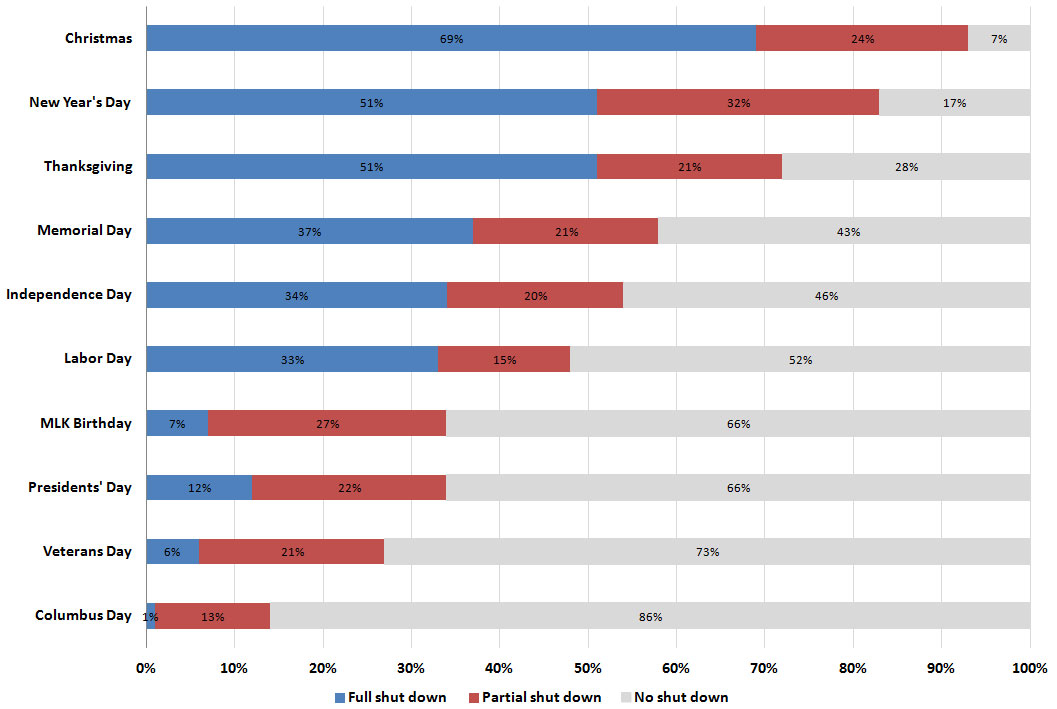Your Building's Favorite Holiday? Not Columbus Day
Updated 12 October 2017
Even though it is an official national holiday, Columbus Day does not get much respect from U.S. commercial and industrial facilities. By "respect" we mean that only about 14% of buildings we sampled show any significant drop in electricity use on Columbus Day.
By comparison, 93% of Christmases, 83% of New Year's Days, and 72% of Thanksgivings did show large drops.
At , we analyze interval meter data from facilities around the world. One of the many things we look for are "shut down days". These are days when most energy-using equipment is turned off for most hours. Like Memorial Day (Monday) in this example:
shows which holidays are and are not shut down days. And this often surprises business owners and facility managers - "why is our energy use so high on Anzac Day (Australia), we're closed?".
 So we thought it would be fun to see which national holidays are most observed by U.S. commercial and industrial facilities, from their electric meter's perspective. On which holidays does energy use most often (and least often) drop.
So we thought it would be fun to see which national holidays are most observed by U.S. commercial and industrial facilities, from their electric meter's perspective. On which holidays does energy use most often (and least often) drop.
We chose 1,000 buildings from our database, all of which have a full year of recent interval data, covering all regions of the country (except Alaska, sorry). We have no idea if this sample is representative of the U.S. as a whole, but it does provide some interesting insights.
Can I take the day off?
 First we counted the number of facilities in our sample which have no shut down days throughout the year. The answer was higher than we thought - 24% had no full days during which most equipment was turned off.
First we counted the number of facilities in our sample which have no shut down days throughout the year. The answer was higher than we thought - 24% had no full days during which most equipment was turned off.
That left 760 buildings which experienced one or more shutdown days during the year, as in the load profile shown above. Electricity use was low and flat throughout these days. Let's call them a "full shut down".
But we often see a less dramatic drop in use on holidays, as in this example from Labor Day (Monday):
While the load is lower than usual, there's still a sizable bump in the middle of the day. Some equipment is still turning on, maybe the HVAC system or lights. Let's call this a "partial shutdown".
Sorry, Christopher Columbus
Next we reduced our sample to those 760 buildings which have at least one full shut down day. We excluded the other 240 on the assumption that they are unable to shut down for a full day, perhaps because their operations are "mission critical" (like a server farm).
Then we categorized each holiday for each building in the remaining sample as "full shut down", "partial shut down", or "no shut down". Here are the results:
These facilities experienced a full or partial shut down for 93% of Christmases, 83% of New Year's Days, and 72% of Thanksgivings.
At the other end of the holiday spectrum, only 14% of Columbus Days see any type of shut down, and the vast majority of these are partial shut downs. As noted earlier, Columbus Day gets no respect! Veteran's Days fare a bit better, 28% experience some shut down in load.
For what it's worth
Let's say we have a facility that fully shuts down for some holidays, but only partially shuts down for others. If we assume that the facility fully shut down for all holidays, how much would have been saved on the electric bill?
Of course, the assumption is inappropriate in some cases because they may be partially open for business on those holidays. But we wanted to see how big the potential savings are.
 Turns out that unless the facility has a very large electric bill, then there aren't much savings here. Using state average retail electricity prices from the U.S. Energy Information Administration, the median savings in our sample is about $50.
Turns out that unless the facility has a very large electric bill, then there aren't much savings here. Using state average retail electricity prices from the U.S. Energy Information Administration, the median savings in our sample is about $50.
In other words, if you waved a magic wand and all partial shut down holidays became full shut down days, the typical facility in our sample would only save $50. A few larger buildings saw potential savings in the low $1,000's, but these were rare.
However, some clients have told us that it was easy to capture these savings, as simple as reprogramming their thermostat.
© Copyright 2025 ENERGYai®













